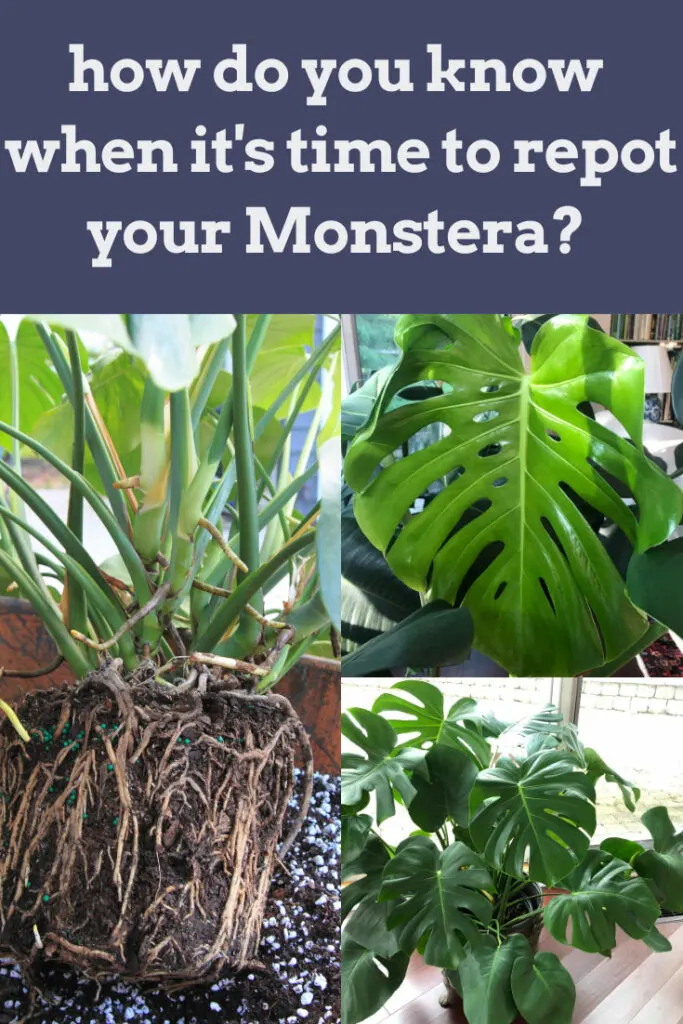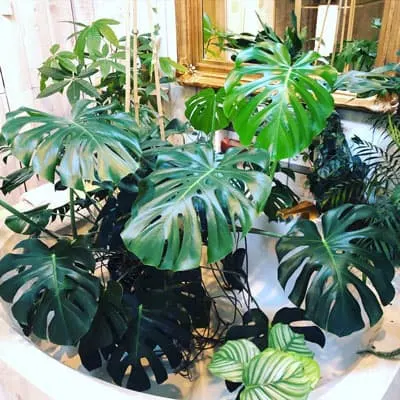Some of the links in this post may be affiliate links.
How do you know when to repot Monstera? If you’re not sure about the timing of repotting Monstera deliciosa, this post will help you determine exactly that. Keep reading, and I’ll give you all the signs you should look for that will indicate that it’s time to repot!

Table of Contents
WHEN TO REPOT MONSTERA
If you leave your Monstera plant in the same pot for too long, you will be slowing down its growth and you will never reach the true potential of these beautiful plants.
Here are 5 signs that you can look out for that indicates that your Monstera is ready for a bigger pot. It can be confusing, but if you read through this post, you will be clear if your plant is ready!
1. Roots coming out of the drainage holes
This is a surefire sign that your Monstera deliciosa most likely needs a new pot. If you see roots creeping out of the drainage holes, go ahead and find a pot that is one size bigger.
For example, if your plant is in an 8 inch diameter pot, only go up to a 10 inch diameter pot. This will allow for more growth to occur, but will still allow the potting mix to dry out in a reasonable amount of time.
At the end of this post, I’ll refer you to my detailed Monstera care and repotting post that you can follow to repot your own plant, along with a whole list of other Monstera blog posts that you may enjoy!
2. Your plant has slowed down in growth (or even stopped)
If your Monstera is severely root bound, the growth will dramatically slow down, even if you have enough light.
So if you’ve noticed that your plant is not growing anymore, despite good conditions, and your plant is severely root bound, it’s time for a bigger pot.

3. Your potting mix is drying out much faster than it used to
As your Monstera pot becomes more and more full of roots, you may struggle to keep your plant hydrated enough.
And if you have been sticking with a strict watering schedule (for example, once a week), you may find that your plant is needing water more frequently than once a week.
For those of you that know me, I strongly believe in not following a strict watering schedule, because your plant’s water needs can vary depending on the season, how root bound it is, and many other factors.
Over time, roots will fill up the pot, potting mix may have been washed out after countless waterings, and it becomes increasing difficult to keep your plant properly hydrated. In these cases, you probably also have roots coming out of the drainage hole, which indicates a need to repot.
4. You’re starting to get a lot of yellow leaves and brown crispy leaves
Building on the previous point, if your plant is root bound, and you’re still sticking with a strict watering schedule, this may be causing the lower leaves on your plant to yellow.
Your watering schedule may have worked for a while, but it will start to fail as your plant becomes root bound.
Anytime you see yellow leaves (which have many causes), you should immediately feel your potting mix. If your plant is very root bound, chances are that you’re having a hard time watering your plant enough, and your Monstera will develop yellow leaves.
Normally the lower leaves will yellow first when your plant is very dehydrated.

Another thing that can happen if your Monstera is very root bound, is that you may start to get brown, crispy leaf tips.

My plant in the photo above has been growing in the same 14 inch diameter pot for a few years.
I have noticed that it is drying out much more quickly than it used to, but I’m not quite sure if I want to undergo the task of repotting a plant that is taller than I am!

So in the meantime, while I wait to summon the motivation to repot such a large plant, I will have to be much more attentive to watering so that I can keep my plant in good shape.
And remember, there is nothing wrong with trimming off brown leaf tips on your Monstera!
5. It’s been more than 2-3 years since you last repotted
Time alone isn’t always a definitive factor in determining if your plant needs to be repotted, but if 2-3 years have gone by and you haven’t repotted your plant, especially if it’s in a smaller pot or is a juvenile plant, it’s probably time!
Of course, you won’t know for sure until you take the plant of its pot…
If you’ve witnessed a combination of at least 2 of the factors above, if not more, it’s probably time for a bigger pot.
I hope you’ve enjoyed this post on when to repot Monstera, and here are several other blog posts that I wrote on Monstera plant care that you may enjoy.
MONSTERA RESOURCE GUIDES
Best Monstera Deliciosa Soil: #1 Guide to 3 Top Recipes
Monstera deliciosa care and repotting guide
Monstera Pots: 3 Tips in Choosing the Best Pot for Monstera
Can you repot Monstera in winter?
Monstera Problems: 15 Frustrating Problems & Solutions
Why is my Monstera Not Growing? 9 Crucial Reasons Why
Is Your Monstera Falling Over? 4 Tips to Keep it Upright
Variegated Monstera: 7 Crucial Care Tips for Thriving Plants
Monstera Deliciosa Fruit: 5 Things to Know About Eating It
15 Amazing Monstera Varieties to Add to Your Collection (deliciosa is only one species!)






